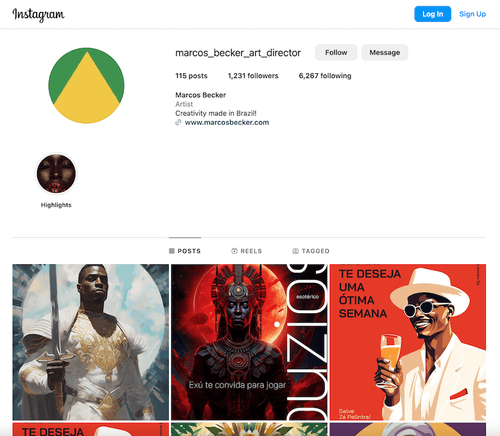
Marcos Becker, a Brazilian designer with a storied career, has navigated the global creative landscape with a philosophy rooted in bold experimentation and unwavering originality. His journey has taken him from the vibrant advertising scene of Rio de Janeiro to the digital hubs of Singapore and Dubai. Throughout, he has cultivated a unique creative process that blurs the line between commercial design and personal art, driven by a deep-seated belief that true creativity cannot be replicated.
Marcos’s career is one of complete immersion in the world of design. ‘If you asked me what I would do if I had another profession or discipline, I wouldn't know how to,’ he admits. After graduating with a degree in what was then called Industrial Design in Brazil, he spent nearly two decades in Rio’s advertising industry. An opportunity to move to Singapore placed him at the forefront of the digital revolution, working with prominent agencies like VMLY&R and later BLKJ Havas. Now based in Dubai, his experience reflects the industry's major shifts over the past two decades.
What sets Marcos apart is his deeply personal and experimental approach to creation. ‘If you look at my portfolio and ask me how I achieved certain assets, I wouldn't know,’ he explains. ‘My work is very experimental, especially in the crafting process. Sometimes, I get a result and don't know how to do it again.’ This one-of-a-kind phenomenon means each piece is unique. He embraces technology, using tools like Midjourney and Cinema 4D to create complex collages where the outcome is often a surprise. ‘The process is very random – the result differs from what I initially thought,’ he says.
This commitment to the unexpected is tied to a fierce belief in originality, a value instilled in him by his Brazilian background. He recalls his time in Singapore, where he saw great designers copying references, a practice he considers unthinkable. ‘In Brazil, you cannot do that… It's a crime. It's amateurish,’ he states firmly. ‘In our culture, you need to be original. The reference can only be a starting point.’ This principle guides his work, ensuring that every project, while perhaps inspired by something, is ultimately a new creation.
Marcos has witnessed the advertising world's evolution from a print-first to a digital-first model. Where campaigns were once designed for posters and then adapted for screens, today’s process is inverted. He sees this shift as part of a larger change in the industry, going as far as to declare that ‘advertising is dead’. For him, the future lies not in broadcasting messages but in building genuine relationships with customers. ‘The future of advertising is how you create relationships with your customers,’ he argues, citing failed product launches like Cherry Coke in Brazil as examples of companies not understanding the local culture. Effective communication, he believes, is a partnership, not a simple client brief.
His own work often recycles ideas that clients may have rejected. ‘If I do something I like, and the client doesn't like it and runs away, I recycle it and use it as art,’ he explains. This practice allows his creative vision to find a home, even if it’s outside a commercial context. He draws significant inspiration from the rule-breaking designer David Carson, whose work crosses the line into art. This boundary-pushing is evident in Marcos’s own portfolio, such as a Durex campaign he created in Singapore. His initial, provocative concept was toned down for the conservative market, but the original design proudly lives on his website, a testament to his creative intent.
Working across diverse markets like Southeast Asia and the Middle East has given him a nuanced perspective on cultural sensitivities. While Dubai is 90% expats, its government is conservative, creating a unique dynamic. He contrasts this with Southeast Asia, where campaigns must be adapted for numerous languages and cultures. For him, the pinnacle of creative advertising comes from Thailand. ‘Thai advertising is the best for me. I love it.’
When asked to describe his style, Marcos is hesitant. ‘I’d prefer it if you guys described my style,’ he says, though he acknowledges a penchant for collages, bold aesthetics, and typography. ‘I want to do something immaculate, or I like to do something very outlandish. I don't like to be in the middle.’ His go-to fonts, Helvetica and Futura, reflect a classic design sensibility.
Despite his global career, Marcos remains deeply connected to his homeland. ‘I work abroad. I don't want to pretend to live my whole life in another country. When I die, I want to die in my own country, back in Brazil.’ He is optimistic about Brazil's future as a democracy and would move back immediately if the right remote opportunity arose. This connection fuels his work, which has been shortlisted at several festivals and is even featured in the permanent collection at Poster House in New York – accomplishments he is proud of because they were for real jobs, not fake campaigns created solely for awards, a dark side of the industry he vehemently dislikes.
—
Want to learn more about Marcos's creative philosophy and his views on the future of design? Read the full interview in GROUNDING, the 4th volume of INTERLUNAR's zine.